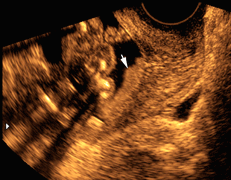
A curious residue of particulate matter, or sludge, that is visible in amniotic fluid via ultrasound may represent an undetected infection and put patients at risk for impending preterm delivery, according to an award-winning report by Jimmy Espinoza, M.D., WSU assistant professor of obstetrics and gynecology and member of the Perinatology Research Branch of the National Institute of Child Health and Human Development.
Dr. Espinoza's retrospective analysis of transvaginal ultrasounds found that 22.6 percent of subjects who had preterm labor with intact membranes, had amniotic fluid "sludge." In contrast, this sonographic finding was found in only 1 percent of patients with uncomplicated pregnancies at term. In addition, amniotic fluid sludge was also associated with microbiological and histological evidence of intrauterine infection. The report deduces that the infection may be triggering preterm labor in patients with amniotic fluid "sludge."
"Microbial invasion of the amniotic cavity is generally prevented by the normally functioning immune system; but microorganisms can sometimes penetrate intact membranes and invade the amniotic cavity. The maternal and fetal host response would be the local accumulation of proinflammatory cells and their products to prevent bacterial colonization; however micro-organisms may protect themselves by embedding in matrices of polymeric compounds that they produce. We believe the amniotic fluid sludge may represent these clusters of bacteria and pro-inflammatory cells," Dr. Espinoza said.
The composition of the sludge is still uncertain, but according to this study, the presence of sludge is significantly associated with a higher frequency of positive amniotic fluid cultures and histologic chorioamninitis, compared to those subjects with no visible residue.
"We propose that this sonographic sign may identify patients at risk for microbial invasion of the amniotic cavity, a condition present in at least 40 percent of all preterm deliveries." Dr. Espinoza said.
This research presentation won first place in its category at the 14th World Congress of Ultrasound in Obstetrics and Gynecology. Co-authors include the following WSU and PRB researchers: Drs. Roberto Romero, Luis Gonçalves, Jyh Kae Nien, Susan Stites, Y.M. Kim, Sonia Hassan, Ricardo Gomez, Bo Hyun Yoon, Tinnakorn, Chaiworapongsa, Wesley Lee and Moshe Mazor.